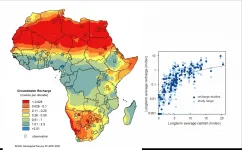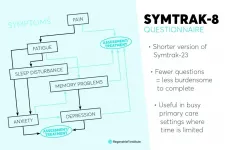(Press-News.org) A new study published in Nature Communications suggests that the extinction of North America's largest mammals was not driven by overhunting by rapidly expanding human populations following their entrance into the Americas. Instead, the findings, based on a new statistical modelling approach, suggest that populations of large mammals fluctuated in response to climate change, with drastic decreases of temperatures around 13,000 years ago initiating the decline and extinction of these massive creatures. Still, humans may have been involved in more complex and indirect ways than simple models of overhunting suggest.
Before around 10,000 years ago, North America was home to many large and exotic creatures, such as mammoths, gigantic ground-dwelling sloths, larger-than-life beavers, and huge armadillo-like creatures known as glyptodons. But by around 10,000 years ago, most of North America's animals weighing over 44 kg, also known as megafauna, had disappeared. Researchers from the Max Planck Extreme Events Research Group in Jena, Germany, wanted to find out what led to these extinctions. The topic has been intensely debated for decades, with most researchers arguing that human overhunting, climate change, or some combination of the two was responsible. With a new statistical approach, the researchers found strong evidence that climate change was the main driver of extinction.
Overhunting vs. climate change
Since the 1960's, it has been hypothesized that, as human populations grew and expanded across the continents, the arrival of specialized "big-game" hunters in the Americas some 14,000 year ago rapidly drove many giant mammals to extinction. The large animals did not possess the appropriate anti-predator behaviors to deal with a novel, highly social, tool-wielding predator, which made them particularly easy to hunt. According to proponents of this "overkill hypothesis", humans took full advantage of the easy-to-hunt prey, devastating the animal populations and carelessly driving the giant creatures to extinction.
Not everyone agrees with this idea, however. Many scientists have argued that there is too little archaeological evidence to support the idea that megafauna hunting was persistent or widespread enough to cause extinctions. Instead, significant climatic and ecological changes may have been to blame.
Around the time of the extinctions (between 15,000 and 12,000 years ago), there were two major climatic changes. The first was a period of abrupt warming that began around 14,700 years ago, and the second was a cold snap around 12,900 years ago during which the Northern Hemisphere returned to near-glacial conditions. One or both of these important temperature swings, and their ecological ramifications, have been implicated in the megafauna extinctions.
"A common approach has been to try to determine the timing of megafauna extinctions and to see how they align with human arrival in the Americas or some climatic event," says Mathew Stewart, co-lead author of the study. "However, extinction is a process--meaning that it unfolds over some span of time--and so to understand what caused the demise of North America's megafauna, it's crucial that we understand how their populations fluctuated in the lead up to extinction. Without those long-term patterns, all we can see are rough coincidences."
'Dates as data'
To test these conflicting hypotheses, the authors used a new statistical approach developed by W. Christopher Carleton, the study's other co-lead author, and published last year in the Journal of Quaternary Science. Estimating population sizes of prehistoric hunter-gatherer groups and long-extinct animals cannot be done by counting heads or hooves. Instead, archaeologists and palaeontologists use the radiocarbon record as a proxy for past population sizes. The rationale being that the more animals and humans present in a landscape, the more datable carbon is left behind after they are gone, which is then reflected in the archaeological and fossil records. Unlike established approaches, the new method better accounts for uncertainty in fossil dates.
The major problem with the previous approach is that it blends the uncertainty associated with radiocarbon dates with the process scientists are trying to identify.
"As a result, you can end up seeing trends in the data that don't really exist, making this method rather unsuitable for capturing changes in past population levels. Using simulation studies where we know what the real patterns in the data are, we have been able to show that the new method does not have the same problems. As a result, our method is able to do a much better job capturing through-time changes in population levels using the radiocarbon record," explains Carleton.
North American megafauna extinctions
The authors applied this new approach to the question of the Late Quaternary North American megafauna extinctions. In contrast to previous studies, the new findings show that megafauna populations fluctuated in response to climate change.
"Megafauna populations appear to have been increasing as North American began to warm around 14,700 years ago," states Stewart. "But we then see a shift in this trend around 12,900 years ago as North America began to drastically cool, and shortly after this we begin to see the extinctions of megafauna occur."
And while these findings suggest that the return to near glacial conditions around 12,900 years ago was the proximate cause for the extinctions, the story is likely to be more complicated than this.
"We must consider the ecological changes associated with these climate changes at both a continental and regional scale if we want to have a proper understanding of what drove these extinctions," explains group leader Huw Groucutt, senior author of the study. "Humans also aren't completely off the hook, as it remains possible that they played a more nuanced role in the megafauna extinctions than simple overkill models suggest."
Many researchers have argued that it is an impossible coincidence that megafauna extinctions around the world often happened around the time of human arrival. However, it is important to scientifically demonstrate that there was a relationship, and even if there was, the causes may have been much more indirect (such as through habitat modification) than a killing frenzy as humans arrived in a region.
The authors end their article with a call to arms, urging researchers to develop bigger, more reliable records and robust methods for interpreting them. Only then will we develop a comprehensive understanding of the Late Quaternary megafauna extinction event.
INFORMATION:
The Max Planck Research Group "Extreme Events" aims to explore the character and impacts of extreme events from multiple perspectives using diverse methodologies. This intersectional project will involve research across the three Jena Max Planck Institutes (Chemical Ecology, Biogeochemistry, and the Science of Human History).
Effective governance and investment decisions need to be informed by reliable data, not only about where groundwater exists, but also the rate at which groundwater is replenished. For the first time using ground measurements, a recent study has quantified groundwater recharge rates across the whole of Africa - averaged over a fifty-year period - which will help to identify the sustainability of water resources for African nations.
The study, led by the British Geological Survey and involving an international team from the UK, South Africa, France, Nigeria, and America, developed a dataset of 134 existing recharge studies ...
Gender equity and racial diversity in medicine can promote creative solutions to complex health problems and improve the delivery of high-quality care, argue authors in an analysis in CMAJ (Canadian Medical Association Journal).
"[T]here is no excuse for not working to change the climate and environment of the medical profession so that it is welcoming of diversity," writes lead author Dr. Andrea Tricco, Knowledge Translation Program, Unity Health, and the University of Toronto, with coauthors. "The medical profession should be professional, be collegial, show mutual respect, and facilitate the full potential and contribution of all genders, races, ethnicities, religions and nationalities for the benefit of patient ...
NASA, in collaboration with other leading space agencies, aims to send its first human missions to Mars in the early 2030s, while companies like SpaceX may do so even earlier. Astronauts on Mars will need oxygen, water, food, and other consumables. These will need to be sourced from Mars, because importing them from Earth would be impractical in the long term. In Frontiers in Microbiology, scientists show for the first time that Anabaena cyanobacteria can be grown with only local gases, water, and other nutrients and at low pressure. This makes it much easier to develop sustainable biological life support systems.
"Here we show that cyanobacteria can use gases available in the Martian atmosphere, at a low total pressure, as their source of carbon and nitrogen. Under these conditions, ...
Hydrogen peroxide is used as a disinfectant, after dilution in water, to treat wounds. It is widely used across the industry as an eco-friendly oxidizing agent for impurity removal from semiconductors, waste treatment, etc. Currently, it is mainly produced by the sequential hydrogenation and oxidation of anthraquinone (AQ). However, this process is not only energy intensive and requires large-scale facilities, but AQ is also toxic.
As an alternative to the AQ process, hydrogen peroxide direct synthesis from hydrogen (H2) and oxygen (O2) using a palladium (Pd) catalyst was proposed. However, the commercialization of the technology ...
INDIANAPOLIS -- Researchers from Regenstrief Institute and Indiana University School of Medicine have developed and validated a short questionnaire to help patients report symptoms and assist healthcare providers in assessing the severity of symptoms, and in monitoring and adjusting treatment accordingly.
The tool, called SymTrak-8, is a shorter version of the SymTrak-23. The questionnaire tracks symptoms such as pain, fatigue, sleep disturbance, memory problems, anxiety and depression in older adults, enabling clinicians to provide better care for the diseases causing the symptoms.
"These symptoms are commonly reported in primary care, but they can be a sign of a variety of different diseases, so tracking them is important," said Kurt ...
Teens may be more likely to use marijuana after legalization for adult recreational use
PISCATAWAY, NJ - Adolescents who live in California may be more likely to use marijuana since adult recreational marijuana use was legalized in 2016, according to a new report in the Journal of Studies on Alcohol and Drugs.
"The apparent increase in marijuana use among California adolescents after recreational marijuana legalization for adult use in 2016 is surprising given the steady downward trend in marijuana use during years before legalization," says lead researcher Mallie J. ...
A new first-of-its-kind study has questioned whether pub operators can effectively and consistently prevent COVID-19 transmission - after researchers observed risks arising in licensed premises last summer.
Led by the University of Stirling, the research was conducted in May to August last year in a wide range of licensed premises which re-opened after a nationwide lockdown, and were operating under detailed guidance from government intended to reduce transmission risks.
While observed venues had made physical and operational modifications on re-opening, ...
A technology that is widely used by commercial genetic testing companies is "extremely unreliable" in detecting very rare variants, meaning results suggesting individuals carry rare disease-causing genetic variants are usually wrong, according to new research published in the BMJ.
After hearing of cases where women had surgery scheduled after wrongly being told they had very rare genetic variations in the gene BRCA1 that could significantly increase risk of breast cancer, a team at the University of Exeter conducted a large-scale analysis of the technology using data from nearly 50,000 people. They found that the technology wrongly identified ...
Recreational drinking, smoking, and drug use is linked to premature heart disease in young people, particularly younger women, finds research published online in the journal Heart.
Those who regularly use 4 or more substances are 9 times as likely to be affected, the findings indicate.
The numbers of new cases of heart disease (atherosclerotic cardiovascular disease) have been increasing in young adults, but the potential role of recreational substance use isn't entirely clear.
To probe this further, the researchers explored whether the recreational use of tobacco, cannabis, alcohol, and illicit drugs, such as amphetamine and cocaine, might be linked to prematurely and extremely prematurely furred up arteries.
They drew on information supplied ...
Ageism, sexism, and Western ideals of the nuclear family have excluded grandmothers from national and international policy initiatives to save newborn lives in the Global South, suggests an analysis published in the online journal BMJ Global Health.
This is despite published research indicating that they are a valuable and influential resource for children's health and survival in many cultures, the study author points out.
Around three out of 4 newborn deaths in the Global South occur in the first week of life--40% of them on the first day, and most of them at home.
But ...






